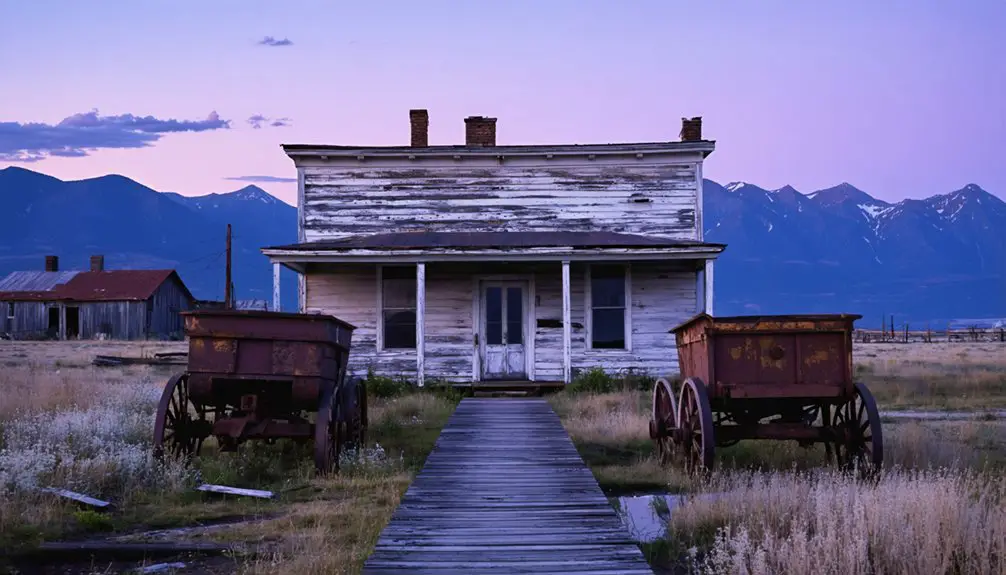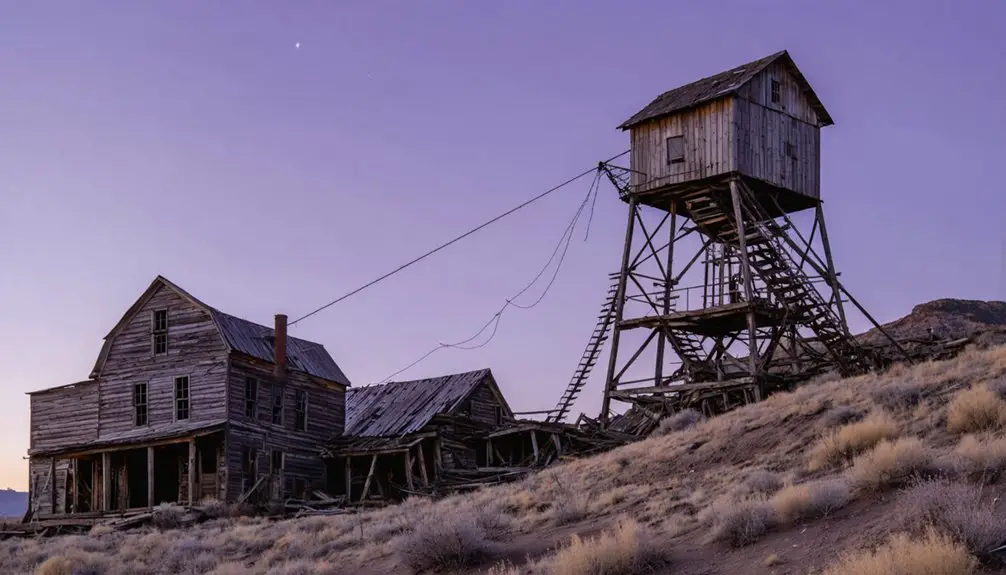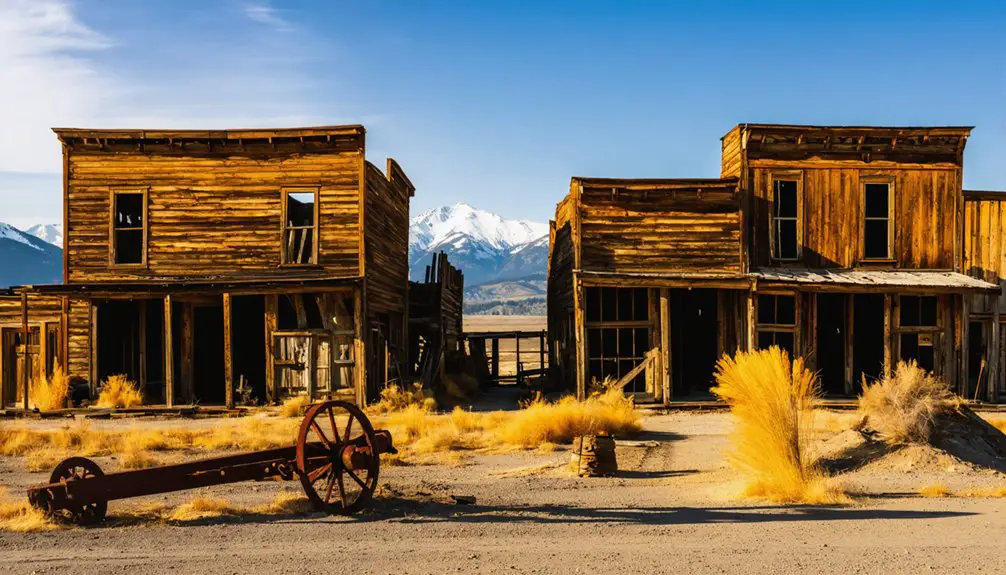You’ll find Nighthawk nestled along the Similkameen River in northern Washington, where gold mining transformed a riverside tent settlement into a bustling town of 3,000 residents in the 1860s. The arrival of the Vancouver, Victoria, & Eastern Railroad around 1900 revolutionized the community, enabling large-scale mining operations and daily ore production. Today, several original structures still stand, including the Nighthawk Hotel and old mill, offering glimpses into this atmospheric frontier town’s compelling past.
Key Takeaways
- Nighthawk became a thriving mining town in Washington during the 1860s, reaching a peak population of 3,000 before declining into a ghost town.
- Original structures from the 1900s mining era still stand, including the Nighthawk Hotel, schoolhouse, mining office, and old mill.
- The Vancouver, Victoria, & Eastern Railroad’s arrival around 1900 transformed Nighthawk into a vital transportation hub for mining operations.
- Located 20 minutes north of Loomis, Washington, Nighthawk offers visitors opportunities to explore historic mining-era buildings and scenic surroundings.
- The town’s economy centered on hard rock mining operations, with six concentration mills extracting precious metals until the industry’s eventual decline.
The Birth of a Mining Frontier
While Washington was still a territory in the 1860s, Nighthawk emerged as one of the state’s earliest hard rock mining frontiers. You’d have found yourself among 3,000 fortune seekers who converged on the Similkameen River, trying their luck at sites like Rich Bar with various mining techniques from simple panning to wing dam construction.
The region’s economic fluctuations became apparent when devastating floods destroyed mining infrastructure, forcing many camps to vanish overnight. Yet pioneers like Okanogan Smith proved the area’s potential, shipping $600,000 in gold during just the first two months of the Similkameen rush. The town’s legacy lives on through its historic mill remains that still stand today.
As placer mining along the river gave way to more sophisticated hard rock operations, you would’ve witnessed the transformation from temporary tent camps to established mining claims that would shape Washington’s mineral industry for decades to come. The area’s development accelerated when the Fifteen Mile Strip opened for claims in 1883 after extensive lobbying efforts.
From Tent City to Thriving Town
After humble beginnings as a riverside tent settlement in 1862, Nighthawk evolved into a formally recognized town that would shape Washington’s mining frontier.
You’ll find that the tent city’s peak saw 3,000 miners swarming to Rich Bar, where an impressive $600,000 in gold shipments flowed through Wells Fargo within just 60 days from a tiny 4-acre plot.
By 1870, the tent city faded, but a new chapter began when Nighthawk Realty Co., led by Myron J. Church and Chas T. Peterson, officially platted the town in 1903.
Though the original tent settlement vanished, Nighthawk found new life when Church and Peterson established the official town in 1903.
The federal Land Office in Waterville validated the townsite in 1904, and the arrival of the railroad in 1905 transformed this mining outpost. The Nighthawk Hotel, built by J.M. Hagerty in 1903, became a centerpiece of the growing community.
The town established itself as a vital supply center for mines in the region, supporting the local mining operations.
Today’s ghost town still showcases the original hotel, schoolhouse, and mining office from its glory days.
The Railroad’s Transformative Impact
When the Vancouver, Victoria, & Eastern Railroad arrived in Nighthawk around 1900, it revolutionized this remote mining settlement‘s destiny.
You’ll find the railroad’s legacy etched into the landscape, from the walkable tunnel beneath the mountain to the former depot that once bustled with activity.
As one of the region’s essential economic catalysts, the railroad transformed Nighthawk from a tent city into a planned town by 1903, complete with hotels, saloons, and stables.
The rail line’s presence dramatically reduced transportation costs and time for heavy mining equipment, while creating a hub for freight companies serving the mineral-rich Similkameen River area.
Railroad spurs connected nearby mining towns, establishing Nighthawk as a significant transportation nexus that thrived until mining’s decline by mid-century. The twice-weekly train service to Nighthawk maintained vital connections for the community’s residents and businesses.
By 1903, the town had evolved into a well-established boom town with essential infrastructure serving thousands of miners.
Mining Operations and Economic Growth
You’ll find that the Nighthawk area’s mining operations expanded considerably after railroad access enabled the transport of heavy machinery and equipment to the region’s mines.
The Ruby Mine and Kaaba-Texas operations became particularly active, with the Kaaba-Texas Mine producing over 100 tons of mixed ore daily during its World War II peak. Among the significant mines was the Nighthawk, which extracted valuable lead and silver deposits through extensive underground workings. Mr. Hegarty, the company superintendent, described the community as being on the boom during this bustling period.
The mines’ prosperity fueled local economic growth, leading to substantial investments in infrastructure, including the Similkameen Falls Light and Power Company’s machinery installations in 1903.
Mining Equipment Transportation
The transportation of mining equipment in Nighthawk relied heavily on the Similkameen River valley and railroad system established around 1905. Railroad logistics enabled the movement of heavy concentration mills, crushing machinery, and refinery components essential for mining operations.
You’d find various makes and models of mills being transported to mining claims, where they’d process lead, silver, gold, copper, and zinc ores.
This robust ore transportation network helped mines like Kaaba-Texas achieve production levels exceeding 100 tons daily during World War II. Local businesses thrived, providing livery services for last-mile equipment deliveries and maintenance support.
When rail service ended in 1950, it dealt a devastating blow to mining operations – you couldn’t efficiently move heavy machinery anymore, leading to the area’s decline.
Ruby and Kaaba Operations
Mining operations at Ruby Silver Mine and Kaaba-Texas formed the backbone of Nighthawk’s industrial success during its heyday.
At Ruby, you’d find bustling silver extraction alongside gold, lead, copper, and zinc production, with onsite concentration mills processing the ore. The Kaaba operations, established in the 1890s, reached impressive production levels of 100 tons daily during WWII, combining various precious metals.
You’ll recognize the mines’ influence in Nighthawk’s rapid growth, as they attracted workers and spurred infrastructure development including railroads, hotels, and supply stores.
The town’s prosperity rode the wave of metal prices until Kaaba operations ceased in 1951, followed by Ruby’s closure. These shutdowns triggered Nighthawk’s decline, leading to the loss of railroad service and eventual depopulation.
Daily Life in a Booming Mining Town

If you’d visited Nighthawk during its peak, you’d have found miners gathering at the town’s saloons and hotel after their grueling shifts in the nearby Similkameen River mines.
Workers would spend long days operating the area’s six concentration mills and extracting precious metals, relying on William Berry’s ferry service to cross between the town and mining sites.
The frontier settlement’s 3,000 residents faced typical mining-town challenges, including primitive living conditions in tents before proper structures were built, though the establishment of a schoolhouse, post office, and other essential services gradually improved daily life.
Social Gathering Places
Life in Nighthawk centered around several bustling social hubs that kept the mining community connected and entertained.
You’d find miners and residents gathering at the town’s hotels, which doubled as venues for community gatherings and social events. The saloons buzzed with activity, offering games and entertainment alongside drinks, while the rail depot served as a daily meeting point for travelers and locals alike.
Local stores weren’t just places to buy supplies – they transformed into informal social centers where you’d catch up on the latest news.
The livery stables, crucial to the town’s freighting operations, became natural gathering spots for workers and visitors. Even the post office, established in 1899, served as a significant connection point where you’d bump into neighbors while collecting mail.
Working Mining Hours
During the peak mining years, you’d find workers toiling away for grueling 10 to 12-hour shifts at Nighthawk’s numerous claims, including the bustling Cabba and Ruby Silver operations.
With minimal mining regulations and labor rights, you’d start your workday before sunrise, descending into the dark underground shafts, and wouldn’t emerge until after sunset. Summer brought even longer hours, taking advantage of extended daylight.
The demanding schedule rarely allowed for rest days, as profit drove continuous operations.
Six concentration mills ran simultaneously, processing ore while trains hauled machinery from Similkameen Falls Light and Power Company.
You’d work alongside specialized operators at the mills, railroad workers managing transport, and various support staff keeping Nighthawk’s mining operations running at full capacity.
Frontier Community Challenges
Beyond the demanding mining schedule, you’d face significant challenges in daily frontier life at Nighthawk. You’d start in a tent, like the 3,000 other miners who arrived in 1865, battling harsh winters along the Similkameen River valley.
As the town grew, hastily built housing and crowded conditions tested community resilience, while basic repairs became a constant necessity.
The transient lifestyle meant frequent goodbyes as neighbors came and went with the mines’ fortunes. You’d find social connection at the saloons and hotels, while the schoolhouse and post office provided stability for families trying to put down roots.
When metal prices dropped, you’d watch the town’s liveliness fade as layoffs mounted and mills closed, forcing difficult decisions about staying or moving on.
Notable Figures and Local Leaders

Several influential figures shaped Nighthawk’s early development, with Myron J. Church and Chas T. Peterson leading the way as town owners and developers through their Nighthawk Realty Co.
The leadership dynamics centered around James M. Haggerty, a prominent attorney who managed major mining estates including the Ruby, Kaaba, and War Eagle mines.
Among the influential entrepreneurs, Hiram “Okanogan” Smith stood out for his 40-year operation of a ranch near Chesaw and his role in the Washington Territorial Legislature. His positive relations with Native American tribes proved crucial to regional stability. The town’s original hotel and schoolhouse remain standing today as testament to its mining history.
Hiram “Okanogan” Smith’s ranch operations and tribal diplomacy made him a cornerstone of early Washington Territory development.
William Berry’s ferry service across the Similkameen River supported the mining community’s growth, while numerous businessmen established essential services like hotels, stores, and saloons that kept the town thriving. Today, Nighthawk stands as one of Washington’s most fascinating historic ghost towns, drawing visitors interested in its rich mining heritage.
Architecture and Historic Buildings
You’ll find several original buildings still standing in Nighthawk from its early 1900s mining era, including the Nighthawk Hotel, schoolhouse, mining office, old mill, and the 1906 railroad depot/store.
These structures were built primarily with wood frame construction and featured practical designs suited to frontier conditions, with some commercial buildings displaying false-front facades to appear more substantial.
Though now weathered and deteriorating, these surviving structures serve as authentic examples of early 20th-century mining town architecture, characterized by their large windows, rectangular footprints, and utilitarian style.
Standing Historic Structures Today
The Nighthawk Hotel stands as the town’s most prominent architectural survivor, anchoring a collection of well-preserved structures from the early 1900s mining boom.
You’ll find the original schoolhouse, mining office, and mill still intact, each showcasing the utilitarian wood-frame construction typical of early mining settlements.
These buildings reflect the town’s historic preservation significance, offering you a glimpse into life during Washington’s territorial mining era.
While many ghost towns have crumbled to foundations, Nighthawk’s architectural significance shines through its standing structures.
The hotel once served as a bustling social hub, while the schoolhouse educated miners’ children.
Though unmaintained, these century-old buildings continue to tell the story of Nighthawk’s dual role as both a mining center and community gathering place.
Early Construction Materials Used
Looking at the architectural remains of Nighthawk today, you can trace the town’s building practices back to its reliance on locally sourced materials.
Wood construction dominated the landscape, with frame buildings housing everything from hotels and saloons to mining structures. You’ll find that builders prioritized quick assembly over permanence, using lightweight materials that were easy to transport to mine sites.
The town’s practical approach extended to its foundations, where structures were placed on naturally level ground with simple post and beam supports.
Buildings featured pitched wood-shingled roofs to handle the region’s snow and rain. While metal roofing became more common after the railroad’s arrival in 1900, the town’s early structures stuck to readily available timber, reflecting Nighthawk’s isolation from major supply chains.
The Decline of Mining Operations

Despite containing substantial ore reserves, Nighthawk’s mining operations declined sharply during the early to mid-20th century as precious metal prices plummeted and operational costs soared.
Economic shifts hit the region hard as demand for gold, silver, lead, copper, and zinc decreased, while primitive mining technology made ore extraction increasingly unprofitable.
You’ll find evidence of these challenges in operations like the Kabba Texas Mine, which closed in 1951 despite having untapped resources.
The region’s remote location didn’t help – miners had to haul ore long distances to smelters in Spokane or Tacoma.
Environmental regulations added further strain when the Okanogan County Health Department required settling basins for tailings in 1946.
Frequent ownership changes and inefficient processing methods ultimately sealed the fate of Nighthawk’s once-bustling mining industry.
Preserving Nighthawk’s Legacy
While mining operations faded into memory, modern preservation efforts have breathed new life into Nighthawk’s historical legacy. You’ll find key original structures like the hotel, schoolhouse, mining office, and mill standing as evidence to early 1900s frontier life, protected through official registration with the Historical Society.
Community engagement drives the preservation efforts, with local volunteers working to stabilize ruins and prevent deterioration.
Despite preservation challenges, you can explore Nighthawk’s rich history through interpretive signage, guided tours, and educational programs. The nearby Enloe Dam, listed on the National Register of Historic Places, adds depth to the area’s industrial heritage.
Through partnerships with tourism boards and historical societies, Nighthawk continues to draw visitors as part of Okanogan Country’s heritage tourism circuit.
Exploring the Ghost Town Today
Today’s visitors can easily explore Nighthawk’s atmospheric remnants, located just 20 minutes north of Loomis, Washington, along the well-maintained Loomis-Oroville Road.
You’ll discover several original structures from the 1900s, including the historic hotel, schoolhouse, mining office, and old mill – each silently telling ghost stories of the town’s mining heyday.
Visitor tips: stick to external viewing of buildings, as century-old structures can be unstable.
The walkable layout lets you wander freely among architectural remnants while photographing the scenic surroundings.
Don’t miss the nearby Enloe Dam, listed on the National Register of Historic Places.
For the best experience, visit during fair weather and bring a camera to capture the authentic mining town atmosphere that’s survived since the territorial era.
Frequently Asked Questions
Were There Any Notable Conflicts Between Miners and Native Americans?
You’ll find mining disputes occurred regionally but not directly in Nighthawk, though cultural clashes between miners and Native Americans happened upstream along the Similkameen River and surrounding areas.
What Happened to the Residents When the Town Became Abandoned?
You’d find that residents’ relocation happened gradually as mines failed, with families moving to nearby towns like Oroville and Loomis. The community dissolution occurred naturally as people sought better opportunities elsewhere.
Did Any Famous Outlaws or Historical Events Occur in Nighthawk?
You won’t find famous outlaws in Nighthawk’s history, but you’ll discover significant events like the 1865 gold rush that brought 3,000 miners and $600,000 in gold through Wells Fargo’s early shipments.
What Was the Average Wage for Miners Working in Nighthawk?
You’d have seen major wage fluctuations among Nighthawk’s miner demographics, with daily earnings likely ranging from $3-5 during the early 1900s, though exact records aren’t preserved from this boomtown era.
Were There Any Major Accidents or Disasters in the Mines?
You won’t find major mine safety disasters documented specifically at Nighthawk’s mines, unlike other Washington mining regions. While disaster reports exist for places like Roslyn, Nighthawk’s operations avoided catastrophic accidents.
References
- http://www.ghosttownsusa.com/nighth.htm
- https://www.scenicwa.com/poi/nighthawk-ghost-town
- http://www.ghosttownsusa.com/bttales20.htm
- https://everydayspokane.com/ghost-towns-in-washington-state/
- https://caddopublicationsusa.com/2017/06/04/ghosts-towns-of-the-west-nighthawk-washington/
- http://www.ghosttownsusa.com/bttales21.htm
- https://stateofwatourism.com/ghost-towns-of-washington-state/
- https://www.dnr.wa.gov/Publications/ger_b5_mining_districts_okanogan_co.pdf
- https://revisitwa.org/waypoint/nighthawk/
- https://okanogancountry.com/ghost-towns



